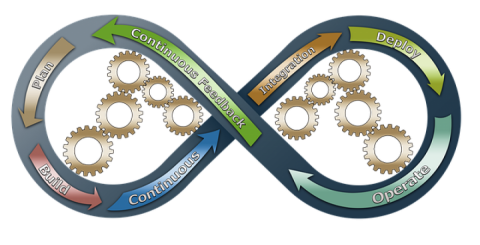Top 10 DevOps Tools To Make Your Life Easy & Work Effortless

DevOps offers a variety of tools and technologies to design, deploy, and test applications in a matter of minutes, with just a few clicks. You can tailor them to client needs and terminate them when not in use. They make processes quick and cost-effective for both the ops team and the development team. Several DevOps tools are making collaboration easy and work effortlessly.
A company that is looking to accelerate production time, improve communication, and reduce cost, must try these ten best tools:
- Ansible: The absolute favorite of almost every company, Ansible, tops this list for a reason. This open-source tool is easy to use and efficient at handling highly complex deployments with simple syntax. It does not hog on your resources and it’s perfect for pushing new changes. Ideal for automating software provisioning, it lowers your infrastructure cost of configuring newly deployed machines and applications. It is also famous for its ability to accelerate the replication speed of scalability. All in all, Ansible is a win-win in terms of cost-effectiveness and time-efficiency. NASA uses it!
- Apache Maven: Highly preferred for automating the build process in Java projects, it is a popular project management tool. Drawing inspiration from the project object model, it uses predefined targets for executing everyday tasks and resolutions. Apache Maven uses XML and most of its features and functionalities come through plugins. The best part - Maven uses convention and not configuration, which means only practical and realistic default values. So, if you’re still using Apache Ant, it’s time you upgrade to Maven!
- Chef: Yet another powerful open-source configuration tool that empowers you to transform your infrastructure into a clean code for efficient management of data, roles, attributes, and more. Compatible with multiple platforms, Chef is easy to integrate with cloud-based frameworks. Irrespective of the size and scope of your IT infrastructure, Chef can automate configurations and app deployments across your networks.
- Docker: This Linux-based platform is portable, secure, and compatible with any language. It focuses on containers, which means you can ship the software & its dependencies in a single package. Docker seamlessly integrates with several tools like Ansible, Jenkins and Bamboo. This open-source enterprise container platform works as a unit to eliminate the hassle of managing dependencies separately. However, this does not mean that you can avoid the cons of poorly architected services with Docker - it all starts with your team!
- Git: Git is another popular open-source platform highly preferred by industry giants like Microsoft, Facebook, and Amazon. It keeps you on top of your development progress and facilitates coordination among team members. Git is great for those who want to experiment as it allows you to revert previously saved versions. You can also create separate branches using Git and add functionalities when the components are ready. However, it is necessary to host a repository such as GitHub for all the work done.
- Puppet: This open-source tool lets you automate software inspection, operation, and delivery. With a solid track record in small projects, it has thousands of modules. It is easy to integrate with multiple platforms. Its free version is an ideal choice for a company with smaller projects. But, if you are managing more extensive projects, consider upgrading to Puppet Enterprise. It lets you handle thousands of resources and manage multiple teams with absolute ease and efficiency.
- Jenkins: Jenkins focuses on the CI/CD pipeline, and it is considered the gold standard for robust deployment automation. Being an open-source automation server, it can be used for reliable configuration management, app deployments, and CI/CD pipelines. Depending on your architecture, toolchain & team structure, you can use a combination of Jenkins, Ansible, and Chef for IT orchestration. A company that wants to ensure greater workflow transparency can use this combination for task automation and app deployment.
- Nagios: Perfect for finding and fixing errors in networks and infrastructure, Nagios is one of the best open-source monitoring tools. Nagios is available in two different editions - Nagios Core and Nagios XI. While both are free, the latter includes more features for a company looking for greater functionality with forum support. You can use it for monitoring apps, network protocols, services & more. It also lets you keep a record of outages and failures.
- Sentry: This free tool comes with inbuilt SDKs and supports JavaScript, IOS, Ruby, and more. It can be customized for compatibility with most languages and platforms. It can continuously monitor scan lines and send notifications in case there is an error in the code. This makes the tool one of the best tools for detecting bugs and problems. Sentry goes the extra mile by not only finding errors but also recommending possible solutions that can be executed with a single click. Microsoft and Uber use Sentry for spotting and rectifying mistakes.
- Splunk: Splunk is a highly innovative tool for a company that wants to boost efficiency and productivity. It makes logs and machine data easily accessible and usable for everyone on your team. Splunk can accurately analyze and visualize much information to facilitate data-driven decisions. Developers can custom tailor Splunk applications and integrate their data into other apps. No wonder Splunk has won several awards apart from making it to the Forbes Digital 100 list.
Whether you choose Ansible, Docker, or Jenkins as your IT orchestration tool, your choice should ultimately depend on your architecture. It is what the project goals you want to achieve. Business enterprises looking to augment and improve their delivery processes can benefit by partnering with a DevOps development company. It helps transform traditional technologies into solution accelerators that facilitate quick collaboration and easy development.
Similar Articles
For modern businesses to thrive, ensuring the effective management of inventory stands has become vitally important. Inventory management stands as a cornerstone of success. And the emergence of the Internet of Things (IoT) has introduced a new era of connectivity and efficiency across diverse industries.
Do you know what the following e-commerce companies have in common: Amazon, Walmart, eBay, and more? All of these e-commerce companies' apps make use of Java. Java is decidedly among the leading choices of programming language for e-commerce applications because it offers a world of benefits; for example, since Java code can be run on any platform with a Java Virtual Machine (JVM), users of e-commerce apps made with Java can access the said apps on a variety of devices.
Nikola Tesla in 1926, once described what is now called a mobile phone as a telephone that can fit into one's “vest pocket.” As otherworldly as that idea was then, nearly a century later, the reality is even more astounding.
Given the staggeringly high amounts of data being generated worldwide every single day, it ought to come as no surprise that organizations often struggle to pick the right tools to help them effectively harness the potential of all their data.
Managing properties can be a difficult task with the right tools. Property owners must find and use the best property management software. It can be a long and tedious process as there are many options in the property management software market.
In the ever-evolving financial services landscape, industry challenges are numerous and complex. From stringent regulations to rapidly advancing technology and changing consumer expectations, financial institutions face many obstacles.
The human learning capability is a great resource for helping technology evolve and grow, breaking boundaries, and creating new ones. Emulating the ability of humans to learn at a gradual but retentive pace, Machine Learning is the latest power monster that is redefining human-machine interaction.
In the ever-evolving landscape of low-code development, Microsoft's Power Platform stands out as a powerful tool for building custom applications. In today's dynamic digital landscape, creating and managing web pages is no longer the exclusive realm of professional web developers
In the data-driven business world, where information is of utmost priority, organizations are increasingly turning to data warehousing and data marts to harness the power of their data. These data management solutions are pivotal in transforming raw data into actionable insights.









